Event Description
The event will be organised by each Volleyball Tournament organised by Paris-Sorbonne University Abu Dhabi (Amaize, Mady & Benson, 2011; Amara, 2005; Amara, 2008).
The event will occur in a place that is accessible and attractive to many people not only for sports activities, but also for tourism, making it an all inclusive event (Amara & Theodoraki, 2010; Amara, 2005; Anwar & Sohail, 2004; Boyle & Haynes, 2009).
The date and time suggested for the event (Saturday the 21st of March at the Corniche gate number 4) is appropriate for all the participants, occurring at a time when most people, students, and other stakeholders have free time to participate and watch the sportsactivities (Yeoman, 2004).
The needs of stakeholders and participants are addressed in the provision of facilities for the sports events (Bromber & Krawietz, 2013; Zagnoli & Radicchi, 2009; Zhang, 2013).

Event Analysis and Adaptation
The event is characterised by:
- Uniqueness.
- Market attractiveness.
- Demand for future events.
- Physical and financial resources available.
- Local support and international support.
- The potential for growth.
- Stakeholder and community relevance.
- Highly skilled participants.
- Availability of job opportunities.
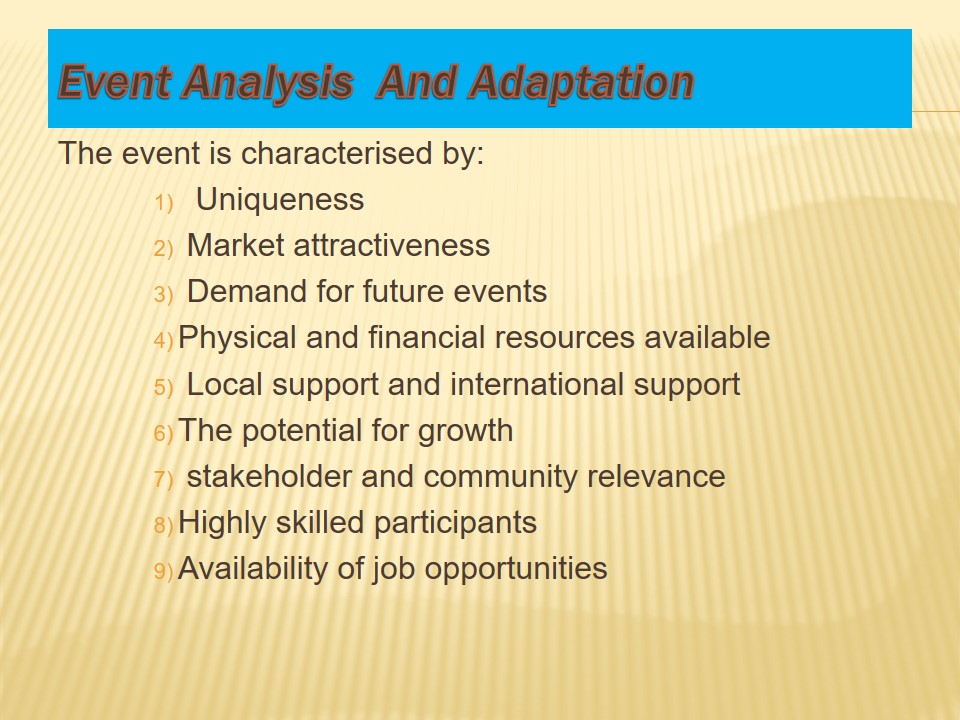
Sponsoring objectives
- Create a stronger brand image.
- Increase brand awareness.
- Show corporate social responsibility.
- Generate revenue.
- Increase market share.
- Create job opportunities in each event.
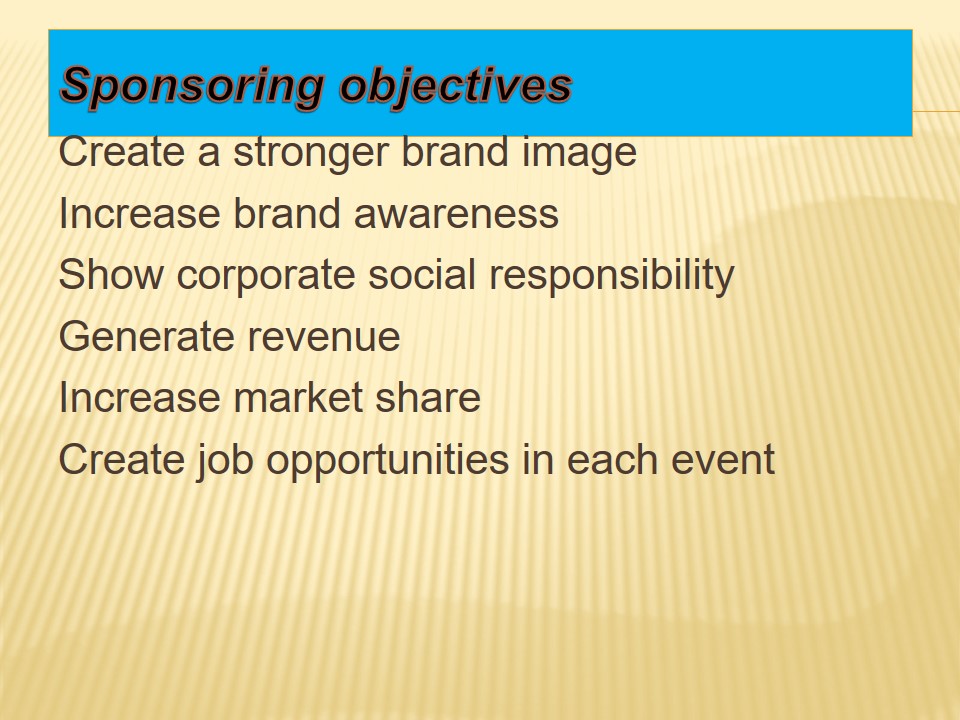
Soles and exclusiveness for top tier partners
- Brand name printed on large bill boards.
- Brand name printed on sports winners packages.
- Listed on publications and other special events.
- Team photos taken with partner brand logo.
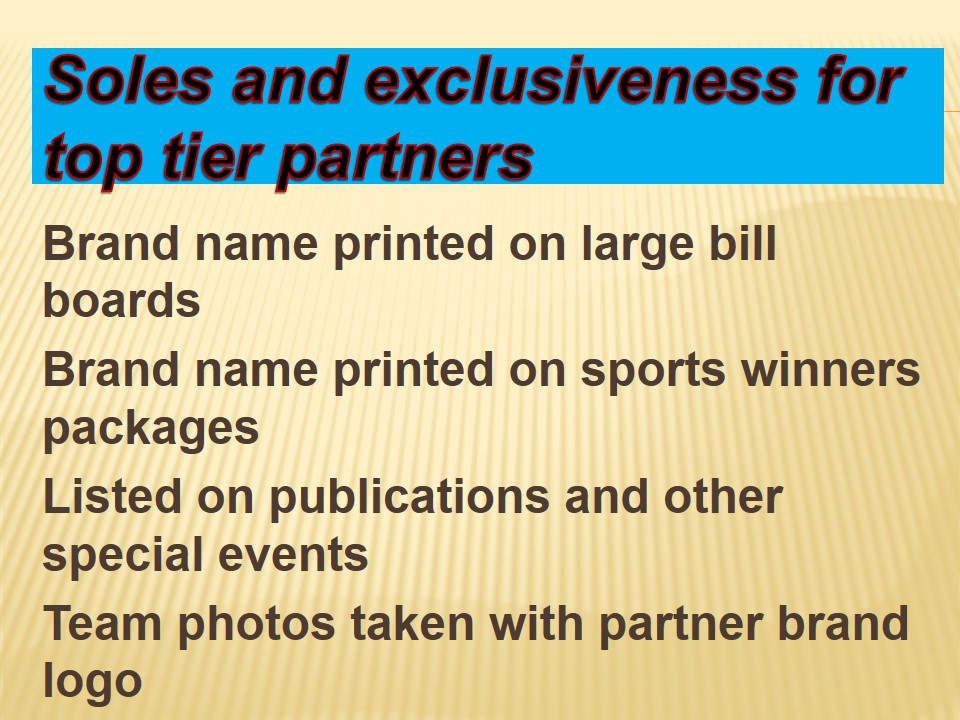
Sponsoring hierarchy and packages
- Platinum Level Sponsor (15000AED):
- Company name on plaque appreciation;
- Name of sponsor on team website;
- Team pictured with sponsor’s brand name in the background.
- Gold Level Sponsor(10000AED):
- Banner and prominent features associated with sponsor;
- Link to sports event website;
- Name printed on T-shirts.
- Silver Level Sponsor(8000AED):
- Link to the event website;
- Name printed on T-shirts.
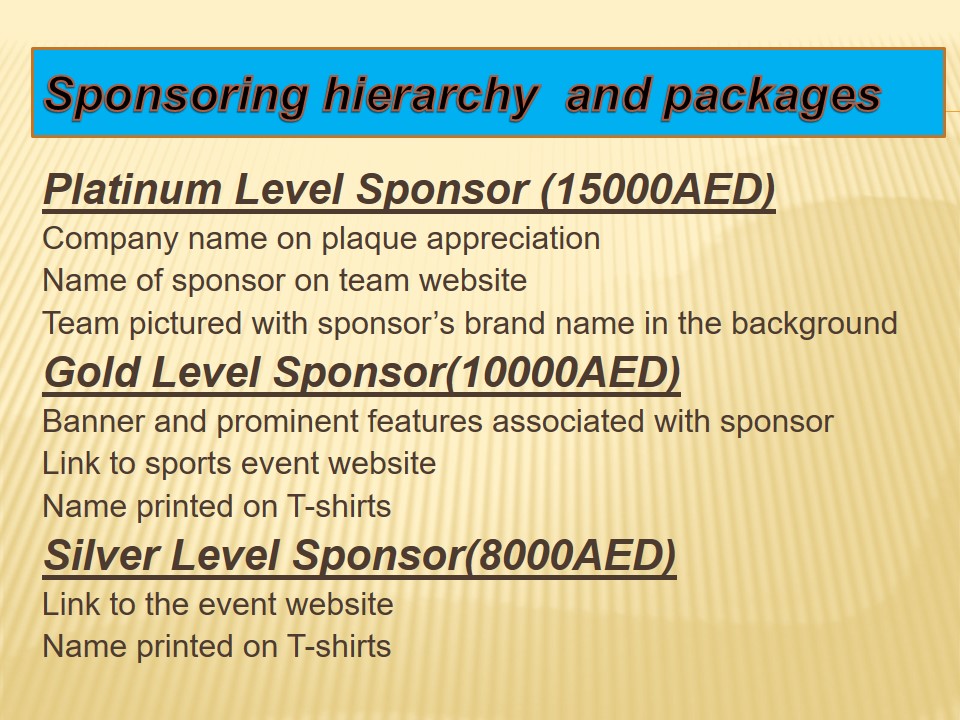
Exclusivity of respective packages
- Sponsorship company name printed on large bill boards.
- Sponsorship name or company printed on T-shirts.
- News letters printed with the sponsorship banner or logo.
- Sponsorship website linked to printed emails.
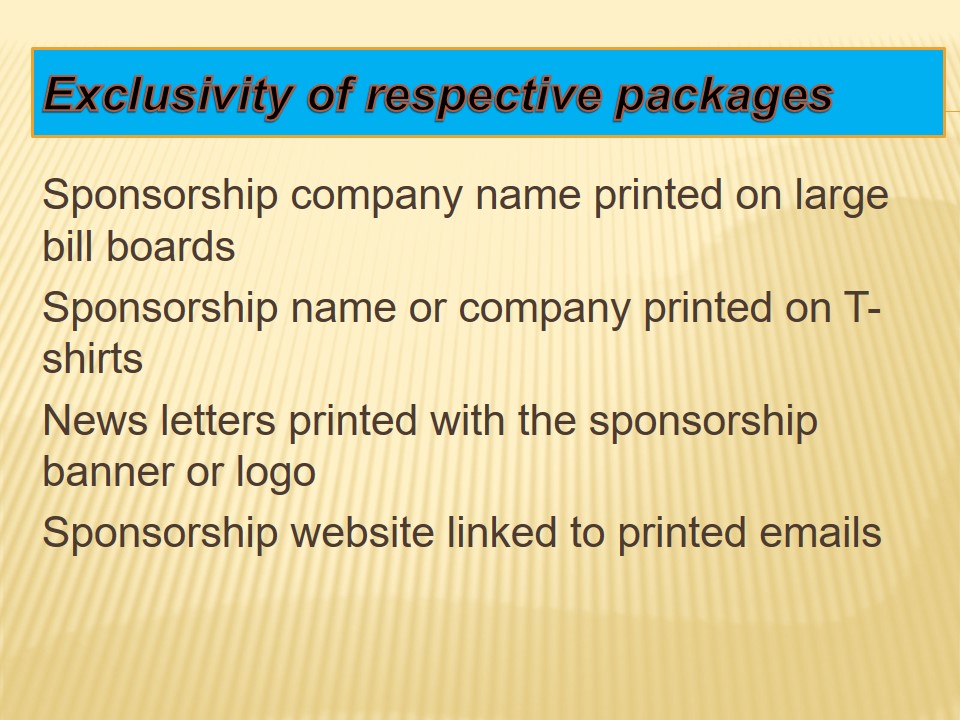
Additional packages to be bought
- Banner signage location (500 AED).
- Balcony wall Banners (600 AED).
- Expo Days featuring sponsors (1500 AED).
- Sponsor Fair Days (5100 AED).
- Scoreboard Signage (1000 AED).
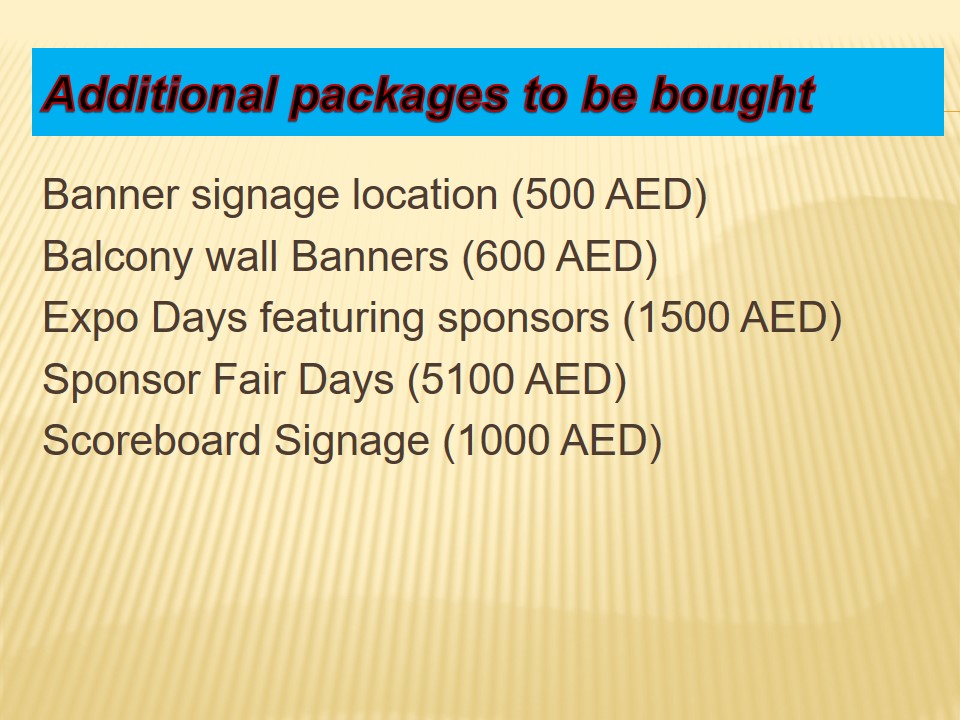
Sponsoring Letter
Name of the company…………………………………………………………………………..
Company representative……………………………………………………………………….
Date…………………………………………………………………………………………………….
The company representative will select the right sponsorship package for the company an sign against the selected package
Platinum sponsor………………………………………………………………
Gold sponsor………………………………………………………………………
Silver sponsor………………………………………………………………………
Signed in the presence of…………………………………………………………………
Cone signed, this form will be submitted to the relevant office or emailed using the official email address.
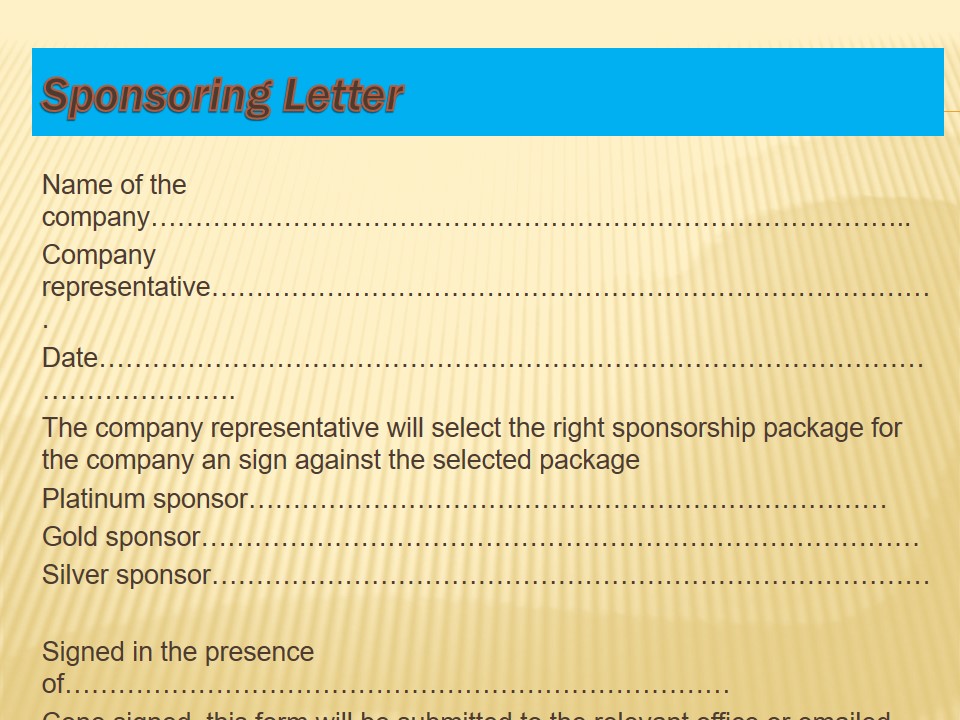
Sponsorship Agreement Platinum Official Sponsor Valued At 15000AED
Name of the company…………………………………………………………
Company representative…………………………………………………
Date…………………………………………………………………
Please specify the sponsorship package from among the following packages.
Platinum sponsor………………………………………………………………
Gold sponsor………………………………………………………………………
Silver sponsor………………………………………………………………………
- Signed in the presence of…………………………………
- once signed, this form will be submitted to the relevant office or emailed using the official email address.
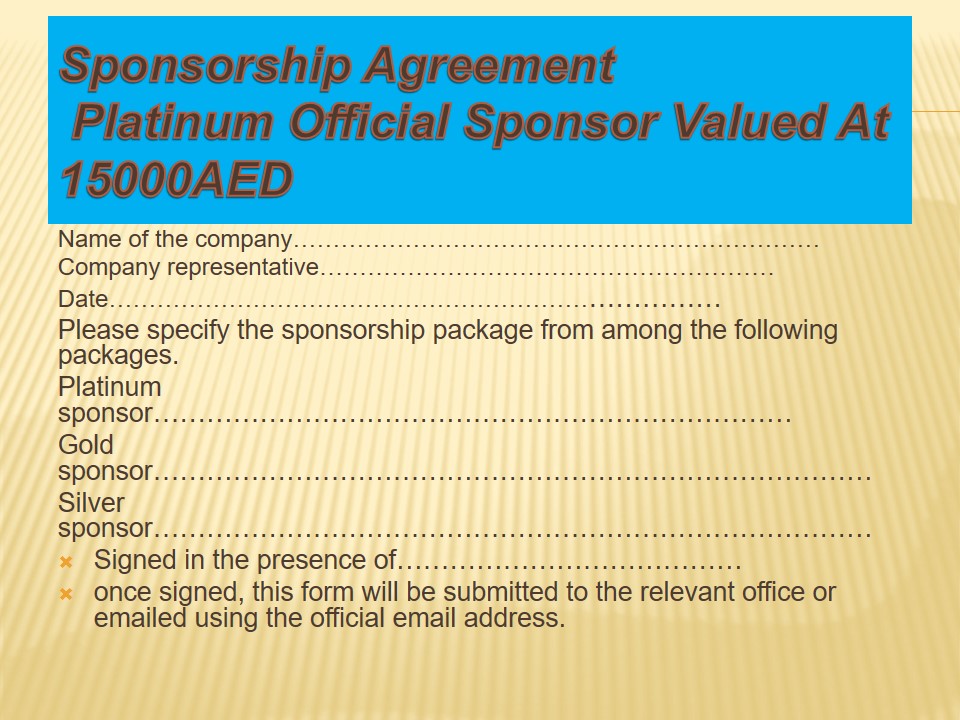
Sponsorship Agreement Gold Official Sponsor Valued At 10000AED
Name of the company…………………………………………………………
Company representative…………………………………………………
Date…………………………………………………………………
Please specify the sponsorship package among the following packages.
Platinum sponsor………………………………………………………………
Gold sponsor………………………………………………………………………
Silver sponsor………………………………………………………………………
- Signed in the presence of…………………………………
- once signed, this form will be submitted to the relevant office or emailed using the official email address.
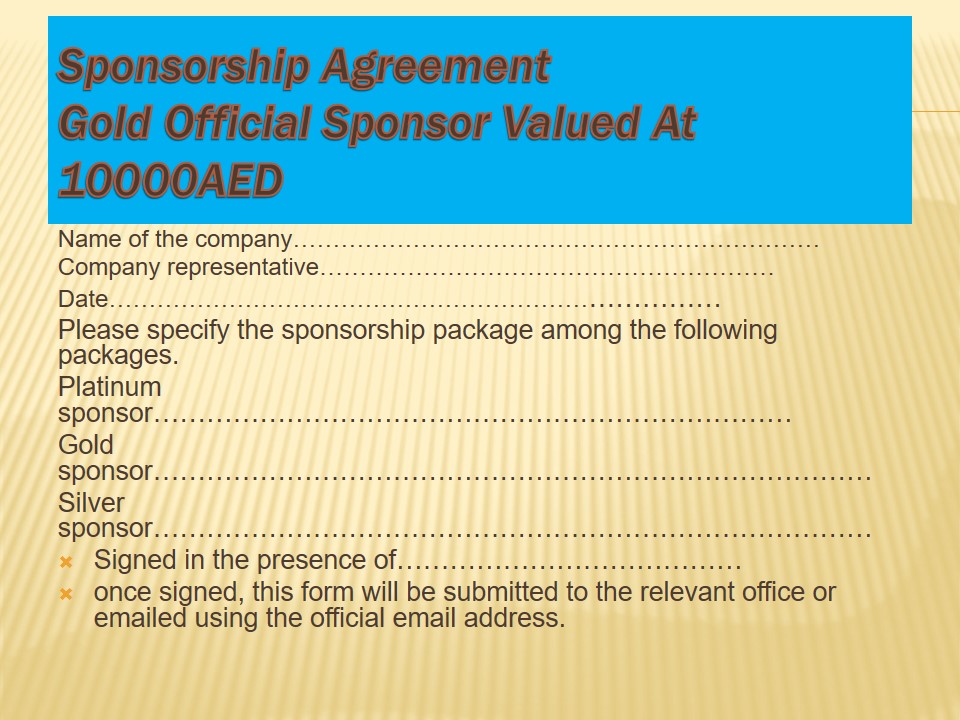
Sponsorship Agreement Silver Official Sponsor Valued At 8000AED
Name of the company…………………………………………………………
Company representative…………………………………………………
Date…………………………………………………………………
Please specify the sponsorship package among the following packages.
Platinum sponsor………………………………………………………………
Gold sponsor………………………………………………………………………
Silver sponsor………………………………………………………………………
- Signed in the presence of…………………………………
- once signed, this form will be submitted to the relevant office or emailed using the official email address.
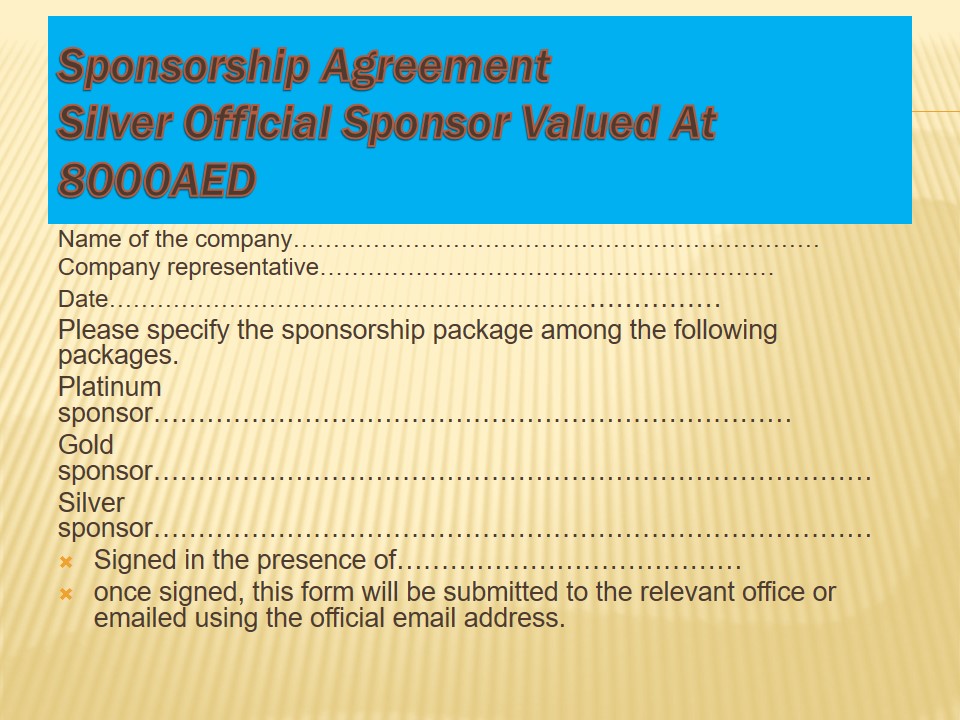
Sponsoring Structure
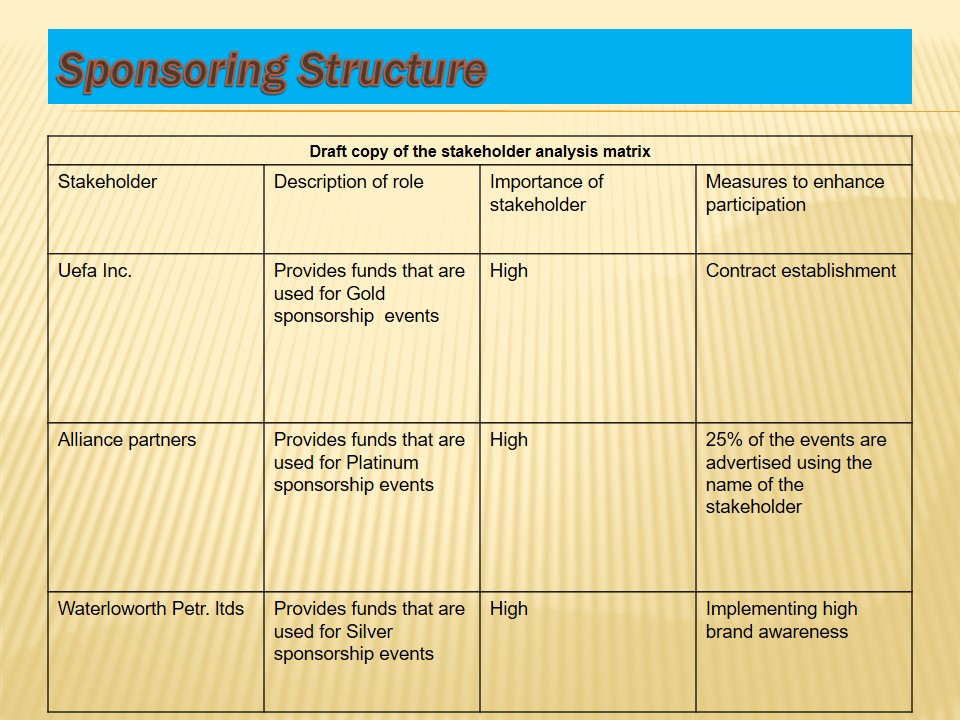
Stakeholder Assessment
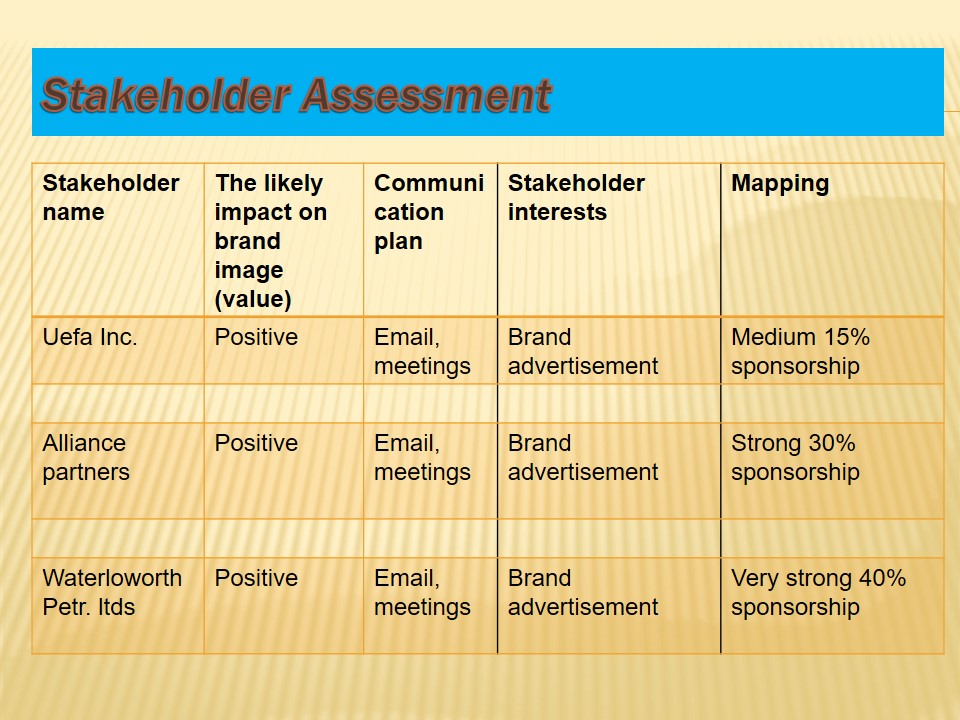
Media/Exclusiveness
- Exclusive coverage will be provided depending on stakeholder contributions to the event and legal agreements between those hosting the event and the stakeholders will be made.
- Sales will be made according to the percentage representation of the sponsors:
- Uefa Inc. – 15%;
- Alliance partners – 30%;
- Waterloworth Petr. Ltd – 40%.
- Once the terms of the contract are accepted and the contract signed, no further changes shall be made in in the contract.
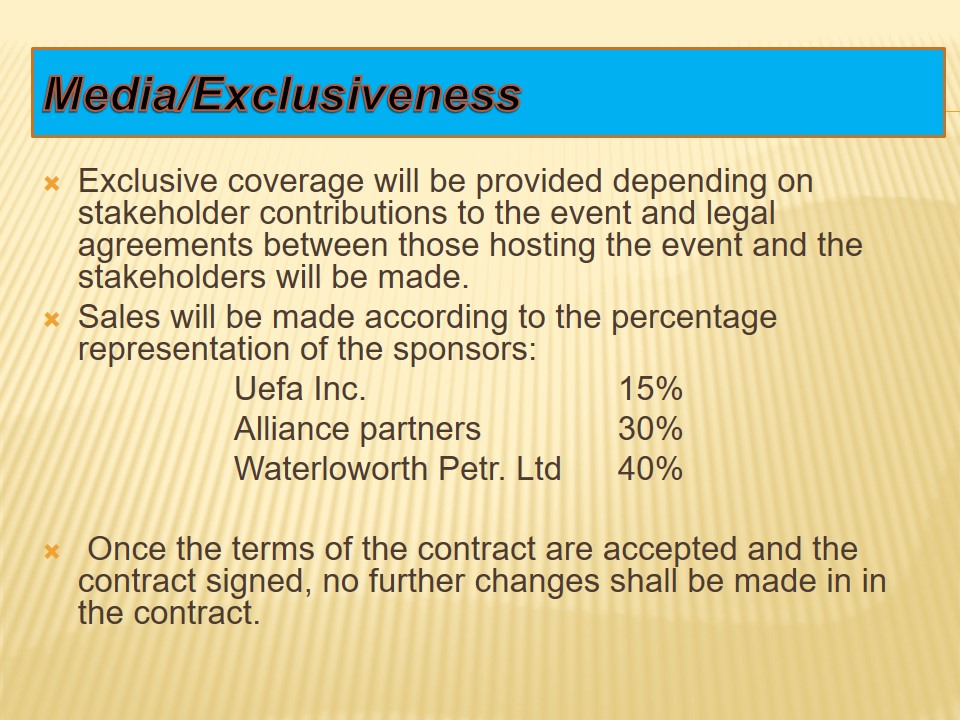
Additional Sponsorship
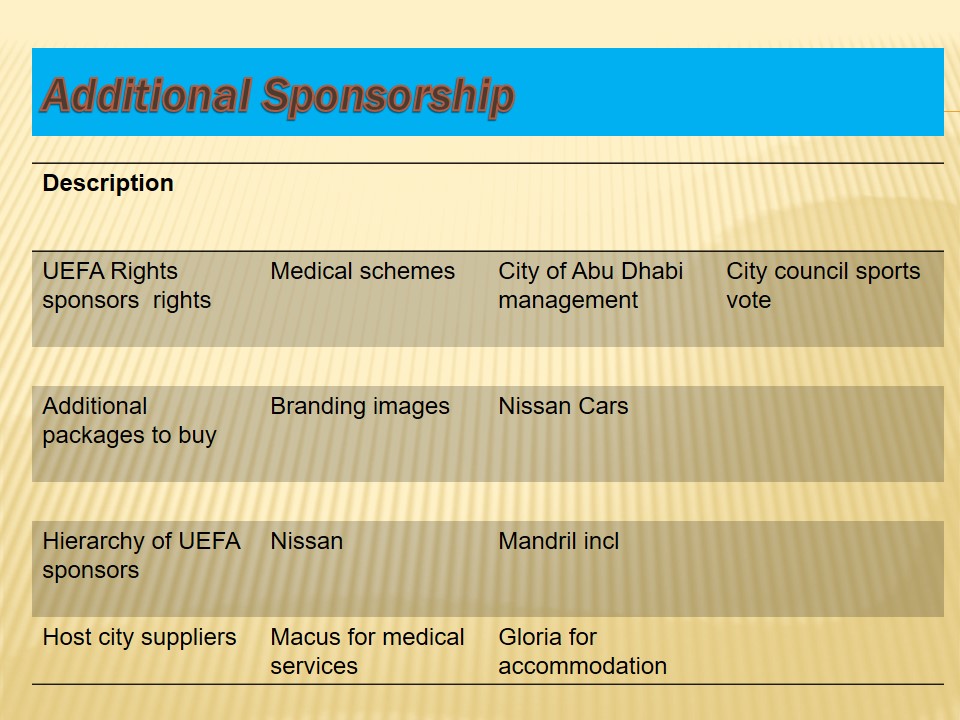
Promotion Plan
Adverts prepared will be inclusive of the target stakeholder brand names:
The goals provide the framework for creating an effective promotion plan and include:
- Analysis of the current start and finish dates-5 days (21st to 25th October).
- Increasing students participation.
- Increasing local communities and families participation.
- Increasing brand awareness of the sponsors.
- Increasing revenue generated from the events detailed description the current market.
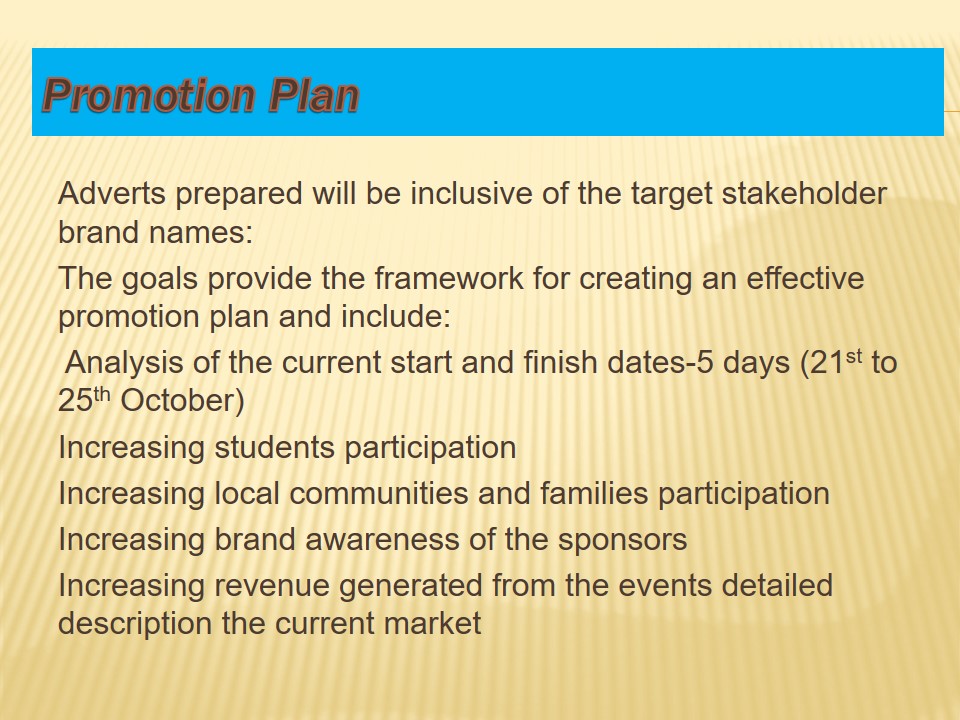
Attracting Participants
- The current market consists of people with different demographic profiles, income levels, tastes, and sports preferences.
- Different events will be held with different implications on the taste of the participants.
- Participants will be given sports T-shirts depending on the lounge they pay for in visiting the events venue.
- Special media coverage will be provided for the sponsors.
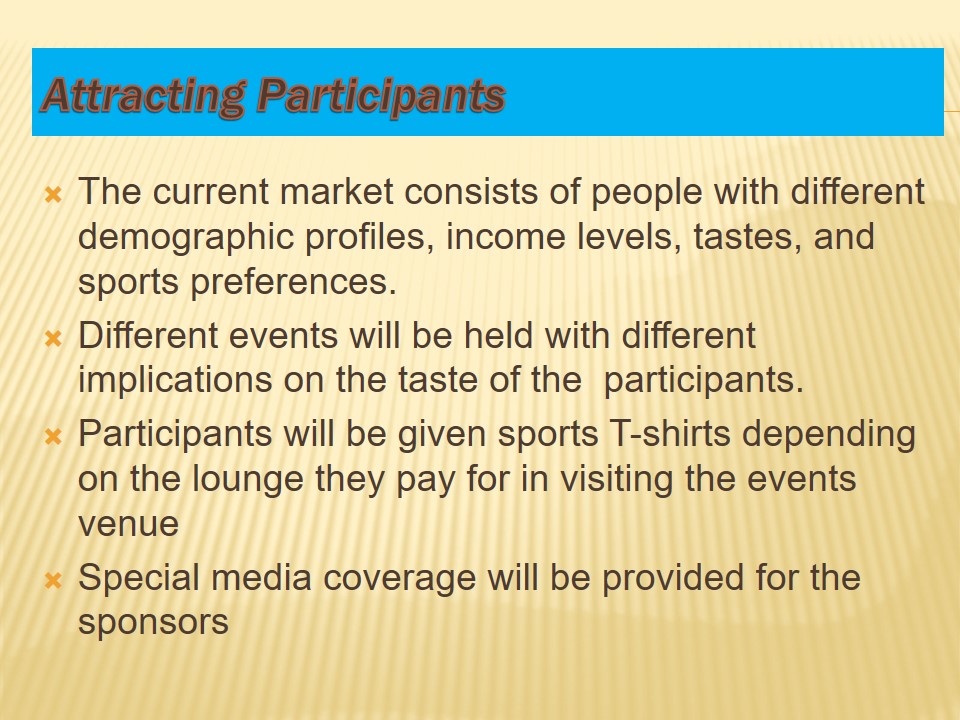
Benefiting
- The council gains by increasing income from revenue generated from the sports events.
- Students explore new opportunities.
- Sponsors find new opportunities.
- More opportunities created because of a good brand name for the council to hold more future events, further increasing sources of revenue (Foley, McGillivray & McPherson, 2012; Al-Hamarneh, 2005; Al-Tamimi,2006; Al Junaibi, Abdulle, Sabri, Hag-Ali & Nagelkerke, 2012; Aldous, 2013; Alrawadieh & Johnson, 2012).
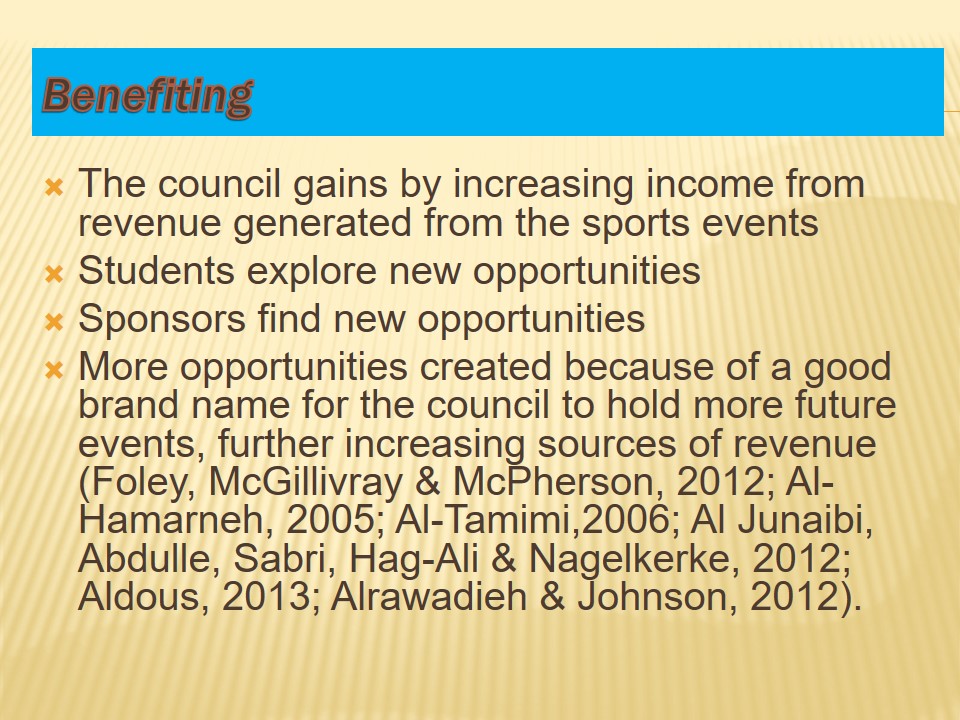
Audience Segment Analysis
- Students-have the highest attendance rate.
- Families-Want their young ones to be inspired Sponsors-Get the opportunity to increase their brand awareness and show their participation in corporate social activities to enhance brand image.
- The municipal council-Will make revenue from the activities and increase the brand presence among sports organisations in the world for future considerations.
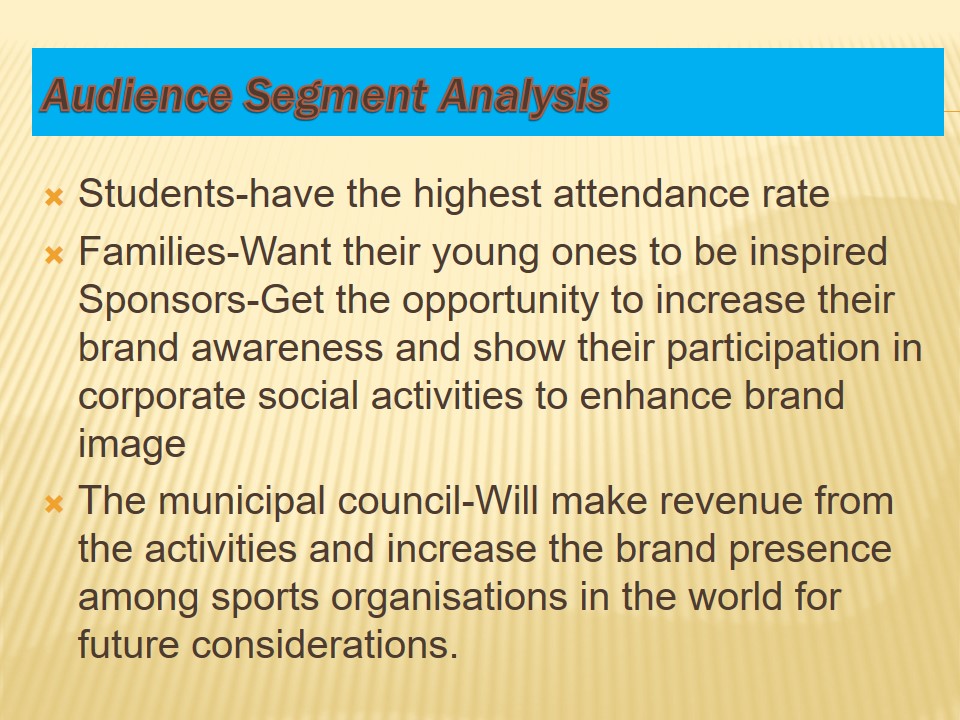
Branding/Hospitality/Rights
- Free medical services provided to stakeholders.
- Branding rights recognized.
- Brand images printed on sports fields.
- Images tagged on clothes.

References
Aldous, D. E. (2013). Research opportunities into horticulture and green open space management in the Middle East. Middle East Horticultural Summit 1051,(1), 77-90.
Alrawadieh, Z., & Johnson, D. (2012). Building Sports Tourism and Event Portfolios–Key Success Factors in Middle East Sports Tourism: A Case Study. London Journal of Tourism, Sport and Creative Industries, 6(7), 30-41.
Al Abed, I. (2007). United Arab Emirates 2007. Winnipeg Canada: Trident Press Ltd.
Al-Hamarneh, A. (2005). New tourism trends in the Arab world. Islamic Tourism, 16(2), 50-54.
Al Junaibi, A., Abdulle, A., Sabri, S., Hag-Ali, M., & Nagelkerke, N. (2012). The prevalence and potential determinants of obesity among school children and adolescents in Abu Dhabi, United Arab Emirates. International Journal of Obesity, 37(1), 68-74.
Al-Tamimi, H. A. H. (2006). Factors influencing individual investor behavior: an empirical study of the UAE financial markets. The Business Review, 5(2), 225-233.
Amaize, O., Mady, T., & Benson, E. (2011). The Need for Academic Programs in Tourism, Arts & Culture, Sports, and Healthcare Management in the UAE. World, 3(1), 96-108.
Amara, M. (2005). 2006 Qatar Asian Games: A ‘Modernization’Project from Above?. Sport in Society, 8(3), 493-514.
Amara, M. (2008). Muslim World in the Global Sporting Arena, The. Brown J. World Aff., 14(1), 67.
Amara, M., & Theodoraki, E. (2010). Transnational network formation through sports related regional development projects in the Arabian Peninsula. International journal of sport policy, 2(2), 135-158.
Anwar, S. A., & Sohail, M. S. (2004). Festival tourism in the United Arab Emirates: First-time versus repeat visitor perceptions. Journal of Vacation Marketing, 10(2), 161-170.
Boyle, R., & Haynes, R. (2009). Power play: Sport, the media and popular culture. Yorkshore, USA: Edinburgh University Press.
Bromber, K., & Krawietz, B. (2013). The United Arab Emirates, Qatar and Bahrain as a modern sport hub. Sport across Asia: Politics, cultures, and identities, 1(1),189-211.
Foley, M., McGillivray, D., & McPherson, G. (2012). Policy pragmatism: Qatar and the global events circuit. International Journal of Event and Festival Management, 3(1), 101-115.
Gupta, A. (2009). The globalization of sports, the rise of non-western nations, and the impact on international sporting events. The International Journal of the History of Sport, 26(12), 1779-1790.
Hassan, D. (2011). Findings of a Competitor Survey undertaken at the Abu Dhabi Desert Challenge 2011 and the event’s associated Economic Impact within the UAE. Abu Dhabi: Mc-Grawhill
Hamil, S., Hassan, D., & Lusted, J. (Eds.). (2012). Managing sport: Social and cultural perspectives. New York, USA: Routledge.
Hunter, D. (2004). Peer to Peer: Effective College Learning: About Alcohol and Other Health Issues. Change: The Magazine of Higher Learning, 36(3), 40-45.
Jackson, S. J., & Haigh, S. (2008). Between and beyond politics: Sport and foreign policy in a globalizing world, 1(1), 9-10
Khalaf, S. (1999). Camel Racing in the Gulf. Notes on the Evolution of a Traditional Cultural Sport. Anthropos, 1(1), 85-106.
Lefebvre, S., & Roult, R. (2011). Formula One’s new urban economies. Cities, 28(4), 330-339.
Loughland, R. A., Saenger, P., Luker, G., Siddiqui, K., Saji, B., Belt, M., & Crawford, K.(2007). Changes in the coastal zone of Abu Dhabi determined using satellite imagery (1972–2003). Aquatic Ecosystem Health & Management, 10(3), 301- 308.
Lohmann, G., Albers, S., Koch, B., & Pavlovich, K. (2009). From hub to tourist destination–An explorative study of Singapore and Dubai’s aviation-based transformation. Journal of Air Transport Management, 15(5), 205-211.
L’Etang, J., Falkheimer, J., & Lugo, J. (2007). Public relations and tourism: Critical reflections and a research agenda. Public Relations Review, 33(1), 68-76.
Madichie, N. O. (2010). Giving the beautiful game a” pretty” bad name: a viewpoint on African football. African Journal of Business and Economic Research, 5(1), 135-151.
Madichie, N. (2010). Getting fans past the turnstiles: UAE football in focus. Working paper presented at the Research Symposium in Business & Economics, American University of Sharjah, UAE.1 (1), 1-13
Madichie, N. O. (2009). Professional sports: a new. The Marketing Review, 9(4), 301-318.
Moeran, B., & Pedersen, J. S. (Eds.). (2011). Negotiating values in the creativeIndustries: Fairs, festivals and competitive events. London, UK: Cambridge University Press.
Morgan, N., Pritchard, A., & Pride, R. (Eds.). (2011). Destination brands: Managing place reputation. Winnipeg, Canada: Routledge.
O’Connor, S. (2013). Sport event management. Managing Sport Business: An Introduction, 1(1), 389.
Pritchard, A., Morgan, N., & Pride, R. (2011). Epilogue: tourism and place reputation in an uncertain world. Destination Brands: Managing Place Reputation, 1(1)347-356.
Quinn, B. (2013). Key concepts in event management. New York, USA: Sage.
Sharpley, R. (2002). The challenges of economic diversification through tourism: the case of Abu Dhabi. International Journal of Tourism Research, 4(3), 221-235.
Stephenson, M. L., & Ali-Knight, J. (2010). Dubai’s tourism industry and its societal impact: social implications and sustainable challenges. Journal of Tourism and Cultural Change, 8(4), 278-292.
Trenberth, L., & Hassan, D. (Eds.). (2013). Managing sport business: an introduction. Winnipeg, Canada: Routledge.
Trimeche, O., Trimeche, M., & Wakabayashi, Y. (2012). Destination branding: managing uncertainties in the MENA region-the cases of Dubai and Tunisia. African Journal of Business and Economic Research, 7(1), 24-46.
Vel, K. P., & Sharma, R. (2010). Megamarketing an event using integrated marketing communications: the success story of TMH. Business strategy series, 11(6), 371-382.
Yeoman, I. (Ed.). (2004). Festival and events management: an international arts and culture perspective. New York, USA: Routledge.
Zagnoli, P., & Radicchi, E. (2009). Do Major Sports Events Enhance Tourism Destinations?. Physical Culture and Sport. Studies and Research, 47(1), 44-63.
Zhang, W. (2013). Analysis of Factors Affecting the Development of Competitive Level of Mountain Outdoor Sports. Open Journal of Applied Sciences, 2(1), 199.